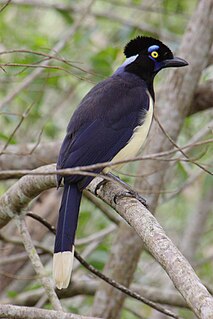 W
WCyanocorax is a genus of New World jays, passerine birds in the family Corvidae. The generic name is derived from the Greek words κυανος (kuanos), meaning "dark blue," and κοραξ (korax), meaning "raven".
 W
WThe azure jay is a passeriform bird of the crow family, Corvidae. It is found in the Atlantic Forest, especially with Araucaria angustifolia, in south-eastern Brazil, far eastern Paraguay and far north-eastern Argentina. It is the state bird of Paraná.
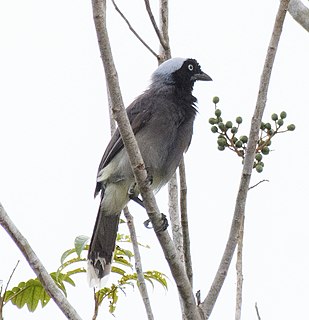 W
WThe azure-naped jay is a species of bird in the family Corvidae. It is found in Brazil, Colombia, and Venezuela.
 W
WThe black-chested jay is a species of bird in the family Corvidae.
 W
WThe bushy-crested jay is a species of bird in the family Corvidae. It is found in Central America, where its natural habitats are subtropical or tropical moist montane forests and heavily degraded former forest. There are two subspecies, C. m. melanocyaneus which is found in Guatemala and southern El Salvador, and C. m. chavezi from Honduras and northeastern Nicaragua.
 W
WThe Campina jay is a passerine from the genus Cyanocorax, a group of jays which occur in the Neotropics. It was first discovered in August 2002 by Mario Cohn-Haft but stayed unrecognised for two and a half years until the holotype was collected in January 2005. In 2013, this species was formally described in the Handbook of the Birds of the World. The species' epithet commemorates Dr. Jürgen Haffer, an ornithologist from Germany, best known for his Pleistocene refugia hypothesis developed in 1969. The common name campina refers to its specific habitat, a cerrado-like open savanna in the Amazon River basin in Brazil.
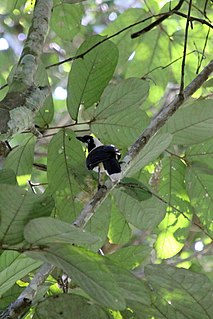 W
WThe Cayenne jay is a species of bird in the family Corvidae. It is found in Brazil, French Guiana, Guyana, Suriname, and Venezuela. Its natural habitats are subtropical or tropical moist lowland forest, subtropical or tropical dry shrubland, and heavily degraded former forest.
The curl-crested jay is a jay from South America.
 W
WThe green jay is a species of the New World jays, and is found in Central America. Adults are about 27 cm (11 in) long and variable in colour across their range; they usually have blue and black heads, green wings and mantle, bluish-green tails, black bills, yellow or brown eye rings, and dark legs. The basic diet consists of arthropods, vertebrates, seeds, and fruit. The nest is usually built in a thorny bush; the female incubates the clutch of three to five eggs. This is a common species of jay with a wide range and the International Union for Conservation of Nature has rated its conservation status as being of "least concern".
 W
WThe Inca jay is a bird species of the New World jays, which is native to the Andes of South America.
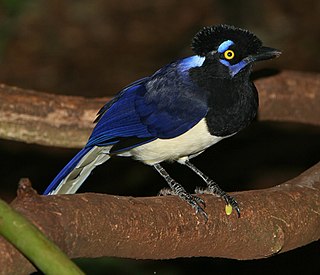 W
WThe plush-crested jay is a jay of the family Corvidae. It is found in central-southern South America: in southwestern Brazil, Bolivia, Paraguay, Uruguay, and northeastern Argentina, including southern regions of the Amazon Basin river systems bordering the Pantanal.
 W
WThe purplish jay is a species of bird in the family Corvidae. It is found in northern Argentina, Bolivia, southern Brazil, Paraguay and southeastern Peru. Its natural habitats are subtropical or tropical dry forest, subtropical or tropical moist lowland forest, and heavily degraded former forest.
 W
WThe purplish-backed jay is a bird of the crow family Corvidae, with purple feathers on its back, wings and tail, and black feathers elsewhere. It is endemic to northwestern Mexico where its habitat is mainly dry deciduous forest. The International Union for Conservation of Nature has assessed it as being a "species of least concern".
 W
WThe San Blas jay is a species of bird in the family Corvidae. It is endemic to Mexico where its natural habitat is subtropical or tropical dry forests; it is a common species and has been rated as "least concern" by the IUCN.
 W
WThe tufted jay is a species of bird in the crow and jay family Corvidae. It is endemic to a small area of the Sierra Madre Occidental of Sinaloa and Durango in Mexico.
 W
WThe violaceous jay is a species of bird in the family Corvidae, the crows and their allies.
 W
WThe white-naped jay is a species of bird in the family Corvidae. It is endemic to Brazil - where it is known as the Gralha Cancã or the Cancão.
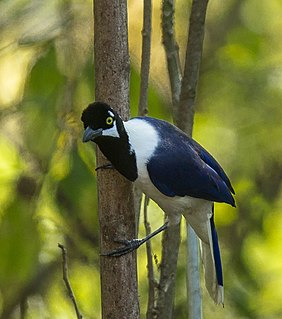 W
WThe white-tailed jay is a species of bird in the family Corvidae. It is found in Ecuador and Peru. Its natural habitats are subtropical or tropical dry forest and subtropical or tropical moist lowland forest. It exhibits no sexual dimorphism. it forages in the open on beetles, ants, and other insects, with a vocal repetitive hollow call.
 W
WThe Yucatan jay is a species of bird in the family Corvidae, the crows and their allies. It is native to the Yucatán Peninsula where its habitats are subtropical or tropical dry forest, plantations and cleared areas at altitudes up to 250 m (820 ft). Adults are about 30 cm (12 in) long, black, with blue wings, mantle, and tail, black bills, yellow eye rings and legs. Immature birds have yellow bills. This is a common species of jay with a wide range and the International Union for Conservation of Nature has rated its conservation status as being of "least concern".